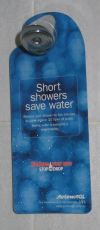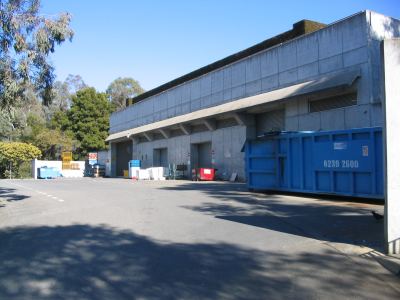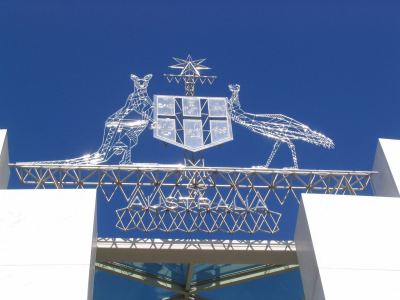(This post backdated to the date it happened, not the date I wrote it.)
 It might have been a negative-something night outside, but the bed was lovely and warm. We awoke, had breakfast and showers, and …
It might have been a negative-something night outside, but the bed was lovely and warm. We awoke, had breakfast and showers, and …
Wait, I should mention the shower. Everything in the serviced apartment we stayed in was great. Except the shower. It was designed by sadists.
The shower head was at about the level of my nose, so I had to crouch down to get my hair wet. A sign extolled the virtues of short showers, but surely that’s not the type of short shower the water authority had had in mind.
Worse, the taps had pointy handles, so as I was crouching, I kept stabbing myself in the back. I don’t think I’m making too much of it by saying that a special place in hell should be reserved for whoever designed that shower.
So, after showering we headed out to (new) Parliament House on foot.
We walked up Canberra Way Avenue and found the back end of Parliament House, including the loading bay and garbage collection area. Very nice. As I snapped a picture of it, Justine backed away in case any security personnel were about to burst out of the bushes and wrestle me to the ground.


Around to the front for the obligatory photos of the big wire coat of arms, through the security check and into the building itself. My, but it’s big. Very damn big. And given how big it is, there didn’t seem to be huge numbers of tourists moving through, though there were a couple of overseas tour groups. It had me wondering why the insides of foreign countries’ parliaments would be interesting to people. It’s not like they’d often see the inside of our parliament on the news or anything.
We found the House of Representatives. The attendant was handing out maps of where each MP sat. Not that it was in session of course, but I managed to spot my local MP’s seat. Similarly in the Senate, they had a map so I could find my state’s senators.
A lift was available to go up to the roof, a big grassed area with the humungous flagpole in the middle (prompting the Get Smart variant joke: “That’s the second biggest flagpole I’ve ever seen”. There was a terrific view over the city from the top.
The roof itself isn’t really that high up off the ground — part of the grassed area actually slopes gently down to nearby the entrance, but it’s fenced off for security reasons. So the building, while huge, is largely underground. Now I’m wondering if it inspired the Teletubbies house.
As we walked down to Old Parliament House, a procession of WW2 jeeps, trucks and motorbikes was coming up the driveway, as preparation for the following days’ VP anniversary events.
After a hot chocolate at Old Parliament House, and a quick look for the famed John and Jeanette Howard postcards (such a sickly thing; perfect for sending to relatives, but alas I could only find John) we got a lift from one friend to another’s house in Florey, a suburb in the North East.
Tangent: transport and urban form in Canberra
This just re-inforced to me how spread out Canberra is. Some naysayers claim that Melbourne is too widely dispersed, too low density to support viable public transport. To that I now say pah, if you want low density, look at Canberra. It’s undoubtedly very green, but everything is so spaced-out so as to make any trip (but particularly on foot) a long one.
There are big gaps of bushland between the activity centres, with not-quite-freeway roads linking them. While the traffic isn’t too bad, so it would be theoretically possible to cycle on the roads, I reckon you’d have to be super-fit to handle the distances.
And there are big gaps between the government buildings in the Parliament House area… for the most part huge carparks that fill with the cars from workers during the week, but leave a concrete and ashphalt desert on the weekend. This makes the entrances to some of the buildings (such as the National Gallery) quite unfriendly for pedestrian tourists. A stark contrast to the National Gallery of Victoria, for instance.

So it does seem that all of Canberra is car-dependent. There are buses, but most of them don’t seem to run particularly often (perhaps every 20 minutes at best), and not many run late at night. Consequently few people seem to use them. The level of traffic isn’t terrible, probably because the population is under half a million. One wonders what the anticipated growth is, and what kind of planning has gone into it, as when and if it reaches a million, there could be dire problems (even beyond the current ones of total car/petrol dependence in an environment of spiralling petrol prices; job catchment and social issues for isolated youth and the poor; and the usual batch of issues associated with the road deficit).
Interestingly, the subject of impending road expansion came up several times in conversations with the locals. One major road project is held up in the courts at the moment, but some (completely unprompted from me) raised the topic of public transport alternatives. Light rail in particular has a lot of backers, but the ACT government seems to have no stomach for it, apparently failing to realise the effects of induced traffic following road expansion.
Back to the travelogue
We had lunch at Marita’s friends’ place, then afternoon tea with my friend Merlin, one of a handful of people I’ve known since primary school. His two and a half year-old son Kai was going gangbusters, which was amusing to watch. Merlin and his family face a similar situation to mine: currently renting in a cold depressing house they don’t like, but light is at the end of the tunnel, as they’re buying and will move in the next few months.
Merlin gave us a lift back to Kingston. We watched the TV news for a bit, trying to find the AFL scores, but eventually gave up and checked them via SMS/PocketNews. Canberra’s TV stations are more focussed on rugby. In fact on Friday night we’d found that with a combination of free-to-air and the hotel’s hobbled Foxtel options, we’d had two channels of rugby, two of cricket, a handful of crap movies, and frustratingly, no AFL.
Then via cab we headed out for the birthday party that had brought us to Canberra in the first place, in a suburb I can’t recall, somewhere around the back of the rather imposing Black Mountain and its viewing/communications tower.

10 replies on “Canberra day 2”
If you’ve got a car you could claim it was nearby; 20 min drive or so from Kingston. Their website claims 10 min from Civic.
When we went years ago, PT required an infrequent Transborder coach (3 or 4 a day and $7 from memory). ACTION now extends there with more services, lower fares but longer travel times (approx 40 min from city).
Your route through Kingston is one of the better services; every 20 min weekdays off-peak. Apart from the intertown route, most others are 30, 40 or 60 min weekdays and 60 min on weekends, finishing 7pm Sundays.
At night fixed-route inbound services have recently been replaced by a Telebus-style service called Flexibus.
I hope you bought a ‘Buspack’ as a momento; $2 for a complete set of timetables & a route map from any newsagent.
The suburb around the back of the Telstra tower could have been Cook or Aranda.
If you think the The National Gallery is pedestrian hostile, then you didn’t catch a bus to the new Parliament House! Buses stop at a lonely shelter around the side, where the bins should be. Unless you are privileged with a pass to get into the side doors, it’s a 500m dark, windswept and unsheltered walk to the front entrance.
The bus stops are not visible from one another, and are 180 degrees apart around Parliament House, so it’s another long walk to go home. There’s room for stops in front of Parliament House, but public transport has zero status in Canberra so such obvious improvements aren’t done (although they are talking about PIDs and busways, with a small group pushing for light rail).
In contrast, Old Parliament House is transit-friendly, although due to the rigid segregation of land uses, it’s a 20-30 min hike to facilities like you’d find at Kingston or Manuka.
Apart from the loops and cul-de-sacs that make walking awkward and require an excessive number of (slow and infrequent) bus routes, the suburbs themselves are reasonably well planned.
All are based around a primary school and local shops. There are clusters of high-density units (up to 3 storeys) around even the smallest local shopping centres. However not even this has stopped some from losing their supermarket. Overall density of housing is not much less than Melbourne outer suburbs, though the provision of generous parkland inside the settled area makes it less.
There is also frequent and effective transport between the town centres, with the intertown service running every 15 minutes until approx 11pm until c1998.
When on holiday, is it too much to expect to have a shower that is at least as good as your home shower? From my experience, that is an unreasonble expectation.
As far as Canberra’s population projections go, current estimates suggest that it’s expected to top out at about 400,000 in the next 30 years or thereabouts (currently 310,000). Canberra’s population growth rate is less than most of the rest of the country at the moment, which is probably a natural consequence of having only one significant employer – the Federal Government – that is probably about as big as it it likely to get anytime soon.
In terms of public transport, whilst taking a bus trip does take some prior thought (ie, you can’t just walk down to the bus stop and expect to be able to jump on a bus in two minutes), in general half an hour between services, even to the outer suburbs, isn’t too bad. And it’s quite cheap, with a $2.50 ticket taking you anywhere in Canberra you like – no zonal system.
My fiancee and I are about to sell our second car and rely more heavily on the public transport system (which I already use to get to work anyway) so it will be interesting to see how that goes, but it’s likely to be quite allright.
As a PT advocate, you might also be interested in looking at ACTION’s FlexiBus initiative – which is sort of like a bus system that operates like a taxi on weeknights. Their website can no doubt tell you all about it.
Marco, the 30 min between buses was pretty much the case around 1994, there were severe cutbacks in 1996, some improvements in 1998 and more cutbacks after 2001. So now it’s a dogs breakfast of non-connecting 20, 30, 40 & 60 min headways.
Reliability was generally pretty good, went through a bad patch c1996 but Guy Thurston did a lot of good in bringing it back up; same with putting timetables at shelters. Scrapping the Busbook though, was a bad move, though individual timetables are good.
Weekend services have always been approx hourly. If you had to be somewhere at a particular time it was pretty much pot luck with a lot of waiting and hanging around.
Thus if your trip was between suburbs, a PT trip required a great deal of planning and overall travel times are likely to be around 5 times longer than driving. For peak hour, 1.5 – 2 times as long only.
But I agree that fares are now cheap; got a bit cheaper when free transfers/timed zones came in and a lot cheaper when zones were scrapped.
When I moved to Canberra from Perth in 1995, I would say Canberra’s system was better. Now I’d say Perth was. But if you’re in an outer suburb of Melbourne, give me ACTION any day!
I’d also be curious how well the Flexi buses worked; if the intertown services were every 15 (and not 20 min) and the Flexi buses were every 15 or 30 min (not hourly) then it could work OK.
But on a cold Canberra night, at least an hourly scheduled bus could be planned for to limit exposure, whereas there could be less certainty with a flexibus ;) OTOH for trips within a flexi bus area, it might work out better.
Not all night services have been replaced with Flexibuses, routes 300, 34, 38 south of Civic and 32 spring to mind as having a night service. 300 [Intertown] is 20 minutely at night, 34 is hourly (Belco-Woden via UC/O’Connor/Turner/ANU/Civic/Parl House/Deakin/Hughes/Garran), 38 south of Civic is hour and a halfly (Dickson to Woden via Hackett, Ainslie, Civic, Russell, Barton, Kingston, Griffith, Narrahbundump), and I can’t remember what 32 via Yarralumla, Giralang and Curtin is.
I’ve only lived here since 2003 and lived in two locations on the same bus route (313) so in many ways my comment on ’30 minutes apart’ is restricted to that service and the other 31x services. I don’t know what it’s like in the inner suburbs.
Come to think of it, on the 313 at least it’s 30 minutes apart during the day and 20 apart in the AM and PM peak.
Unfortunately, where public transport in Canberra (and most other places) doesn’t work all that well is when you take ‘unconventional’ trips. That is to say, if you’re going from your house to a town centre or Civic it’s likely to work out fairly well in terms of time and convenience. But if you wanted to go from one suburb to another one and they weren’t on the same route, you’d very quickly run into problems with waiting a long time for connections and so on.
I haven’t tried Flexibus yet – I should do it sometime just to see how it works (and I’ll probably have to at some point when we sell our second car).
Its Canberra Avenue, not Way. The only ‘Way’ in Canberra is Parkes Way as well as Eastern Valley way, the former of which is a semi-freeway.